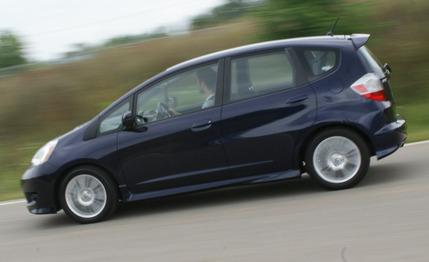 Short Take Road Test
Short Take Road Test

When people ask us for car-buying advice, we invariably throw our most recent January issue at them and point to the 10Best Cars list. There might be an annoyed grunt thrown in there somewhere. This reaction comes not because we don’t like talking to people about cars but instead because they likely won’t listen to us anyway, and the one week we spend each year selecting these cars is enough work without later having to explain the results to friends and family who have inexplicably failed to subscribe to our magazine or read our interweb bleating.
We mention this as we’re preparing once again to head to the back roads to select our qualified top-10 roster. For three years running, the cheapest vehicle on our list has been the Honda Fit, and so it follows that it is the best cheap car. But does it still satisfy when made slower and slightly more expensive by way of an automatic transmission?
How Much Slower, You Ask?
When we got the acceleration test results, they were all positive. That’s positive in a bad way, as in, “We’re sorry, Mr. Gluckman, but the test came back positive.” With the Sport automatic, the sprint to 60 took an extra 1.4 seconds (9.9 vs. 8.5), and the quarter-mile was accomplished 1.0 second slower (17.6 vs. 16.6) at a lower speed (79 mph vs. 83). Skidpad grip and braking performance from 70 mph were basically unchanged.
Quantifiables aside, the Fit Sport’s auto is as good a unit as anyone could expect from a car of such economical purpose, with crisp shifts when the lever is in D as well as S (for sport) mode. The Sport’s steering-wheel-mounted paddles allow full manual operation and the ability to hold a cog right up to the 6800-rpm redline; D and S will shift at 6500 rpm, just shy of the power peak. Unlike some other manufacturers’ sporty shift modes, this transmission’s will stay way down in third when fifth would be drive’s choice. It will also accept multiple shift requests in succession, whereas even some of Mercedes’ AMG transmissions require a beat between paddle thwaps. The auto’s loss of gusto isn’t unnoticeable, but the engaging qualities of this slushbox manage to retain most of the funky Fit’s fun nature.
Two Kinds of Economy
Interestingly, the Fit Sport auto is rated at the same 27 mpg city/33 mpg highway as are manual Fits, whereas the plain, non-Sport auto is rated at 28/35, so there’s a small sacrifice for the fun and control of the Sport’s shift mapping. We managed 28 mpg with this example and have previously milked 31 mpg out of a manual model.
As for the reduction in cheapness, the basic auto tacks $850 onto the bill, but to get the S mode and manual paddles you have to opt for the Sport trim level, itself an additional $1560 expenditure. (Sport also adds such necessities as keyless entry, cruise control, two more speakers for the stereo, and a USB audio interface, plus aesthetic niceties like a hatch spoiler, body kit, and chrome exhaust tip; the chef recommends.) Our top-spec model also bundled navigation with stability and traction control—the only way to get that safety tech is to get nav—for an additional $1850. Even once it’s all summed up, you still can’t order a Fit from the factory for more than $20,000, although dealer accessories like floor mats (all models come bereft of them) and wheels can take you past that mark.
We’d certainly recommend the manual Fit first, for the obvious enthusiast reasons. But as far as cheap cars go, the Fit Sport automatic offers the best manual substitute for commuters or the clutch averse. So if you’re one of our friends and want new-car advice, there it is—just try not to be offended if we throw a magazine at you.